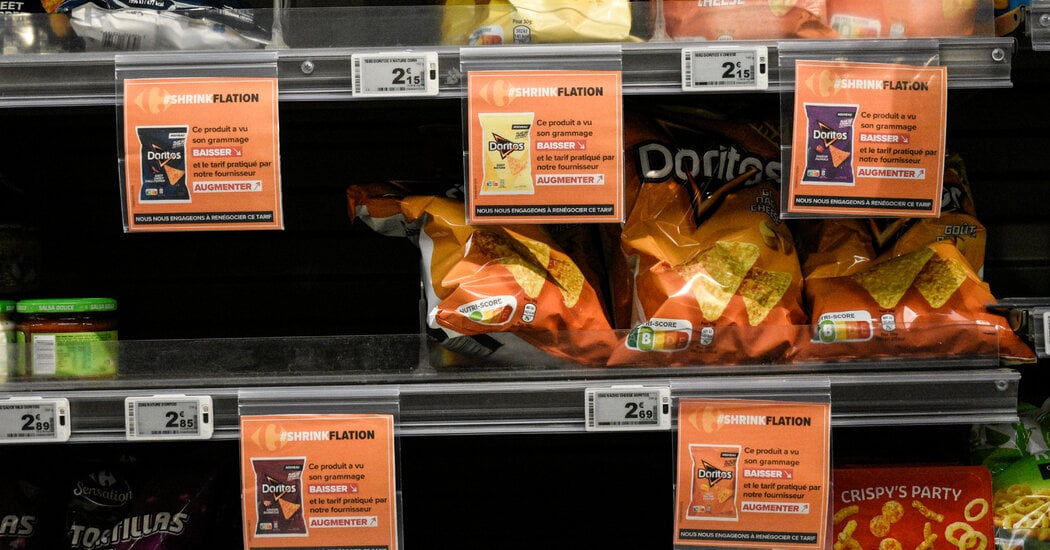We all need to apologize to France for literally every mean thing we ever said about them.
I wish we had a small percent of what France does for its consumer rights in the United States.
That’s because we don’t set shit on fire every time the government looks at us wrong.
Perhaps it’s time to change that
Impossible when 30% of the country is addicted to a 100% propaganda channel
if that 30% were able to do so much damage, the other 70% can do even more.
The other 70% consider political activism posting memes on places like this.
Bringing awareness to issues (even through memes) is a good way to get people who are capable of fighting in on the fight.
What also tends to happen though is that when an issue gets popular, some people jump on the bandwagon for the dopamine hit that comes from the attention they get when they make content about the issue. Hell, even when they don’t make it. I’ve seen stickied comments on clips of popular music videos (just one ridiculous example) posted by fans where they’re saying shit like, “Oh my god guys! Thank you so much for all the likes and comments! I didn’t expect this to be so big!” Ummm, it’s a Beatles clip my guy. You didn’t do anything but reupload a bit of it in short form. You out here acting like you just a member of the band caught off guard by how many people like you.
I always have to be a dick and ask, “Oh, you made this?”
1/3 will do nothing but sit and watch while the other 1/3 kills the remaining 1/3 and that do-nothing-1/3 will call you a tankie and fight you if you try to do anything.
The real reason the 2A exists and continues as-is: it lets those elites in control rile up the stupid masses (that they keep that way) to literally murder the people trying to fix how fucked up shit has become
What’s great about this comment is that every side can say it about the other!
I agree, but it’s also worth noting the influence of police forces, riot police, swat teams, and the national guard.
The US basically has an occupying army to quell unrest in every county across the country, so it’s harder to properly protest without state retaliation. Not to say we shouldn’t do it, but I can understand people’s reticence.
If only they had a right to an armed militia ha ha ha ha ha
Fr. Leftists need to exercise their second amendment rights way more.
Plenty do. There just needs to be more organization.
You’re right. We have idiots setting themselves on fire in front of courthouses instead.
That’s why the French protest all the time. They fight for their rights.
I think it’s lobbying. The US market is so big it pays off to lobby hard.
Corporations are people and people are allowed privacy, so corporations don’t have to tell you anything, pal!
THAT’S AMERICA BABY LOVE GETTING STEPPED ON AND ASK FOR MORE OR QUIETLY GET STEPPED ON AND GET MORE ANYWAY HOOOOOAH 🦅🦅🦅🦅🎆🎆🎆🎆
~(Help us)~
That is what a respectable government looks like
It feels a bit “least we could do” ish?
They’re not setting standard size scales for basic products or establishing price floors based on wholesale/production costs, much less intervening to increase supply or reduce overhead costs.
This is a bit like the surgeon generals warning on a pack of cigarettes. Nice, I guess. But hardly a game changer.
Meanwhile in America
Haha big business go brrrrrr
I feel it’s a good first step.
It’s a third or fifth step. They already have laws against wastage, throwing out food, etc.
This has been the law in Brazil for more than 10 years now. We have lots of problems here, but at least our consumer protection laws are top notch. And, believe or not, they’re enforced successfully.
Thanks for sharing, it’s great tk hear and I didn’t know!
For real? I live in brazil and never noticed any warnings on price increases, or size changes…
I was wrong in one thing, it hasn’t been a thing for 10 years, but for 20. It was determined by the Minister of Justice, based on article 55 of the Consumer Protection Code. More here. I remember seeing some warnings on labels back when the rule was new. My opinion is that companies got smarter and realized that those warnings were damaging to their brands, so they just stopped with the practice of shrinking products, which is why you never noticed.
Será que é por isso que sempre tem aqueles avisos de “nova embalagem”? Ou talvez fique escrito nas letrinhas pequenas atrás? Nunca percebi algo assim, mas muito legal saber que essa lei existe!
edit: se pesquisar por “reduflação” no google imagens, aparecem vários exemplos disso. Estou impressionado que eu nunca via algo assim…
Really we just need to standardize sizes for consumer goods. For example: drinks can come in 250, 500, 750, 1000, and 2000 mL sizes. Sold soap must be sold in units of 100, 500, or 1000 grams. And so on…
But then you get shrinkflation in the product itself. Less emulsifiers in the soap, drinks with corn syrup replacing sugar, and powders like cinnamon cut with lead powder.
Not saying it couldn’t be done, just that businesses are really incentivised to find the loopholes and exploit them.
In Australia we call this “skimpflation” because they aren’t shrinking the final product, they’re skimping on ingredients to lower production costs.
It’s the bane of my existence because brands I know and love will change their ingredients without warning and without changing anything on the packaging (sometimes not even changing the ingredients list! If the ingredients list has always just said “starch” they don’t have to change anything going from arrowroot starch to cheaper potato starch)
I have allergies and I’ve bought two boxes of the same product at the same time, and had an allergic reaction to one, but not the other.
I used to always blame it on my housemates not washing the cooking utensils properly, but I now use separate cooking equipment and I clean down the kitchen before I start and cook at odd times so I’m the only one using the kitchen.
I’ve started emailing companies after my allergic reactions to determine if they have changed an ingredient, and 90% of the time they confirm they have changed the ingredients. Usually they put some PR spin on it about the new ingredient being more allergy friendly or sustainable (they don’t clarify “environmentally” so I assume they mean “financially sustainable for the profits of our company”)
Here they label this as “New Recipe!”. As if they’re somehow doing us a favour.
Oh gee I wonder what inspired you to change the recipe 🤔
Less emulsifiers in the soap, drinks with corn syrup replacing sugar, and powders like cinnamon cut with lead powder.
Standard formulas for a given product. Anything that isn’t 40% sugar drink is “immitation soda drink”. Anything that’s under-emulsified can’t be called real soap.
These are solvable problems at a regulatory level. But at some point, it may be more cost efficient to simply nationalize the under-performing industry. Perhaps Coca-Cola just can’t cut it making soda drinks anymore, and the firm needs to be broken up and devolved to the various states as State Soda Bottling Company
You are seriously underestimating the complexity of products and how easy it would be for them to skirt such legislation
It would be a massive endeavour for regulators which companies may bypass by industry… This is not the right approach
You are seriously underestimating the complexity of products
Again, if the regulation process becomes too burdensome, sometimes the only practical solution is nationalization.
We used to have standardized package sizes in the EU for things like butter, chocolate, etc. So stupid to give that up
I guarantee it’s because of neoliberals and conservatives trying to emulate The US.
It was in the name of customer convenience and individualism of course. Think of the singles!
I think the unit price should be more prominent than the price per item.
And the units should be consistent. It drives me nuts when I’m in a store and the unit varies across different sizes of the same product.
Who the fuck even knows what the unit price of paper towels is?!
Turns per roll on one brand, grams per inch for the next, and ounces per half-roll for your third choice.
And each brand has a different tear-off square size. Some have ‘jumbo size’ and also ‘pick-a-size’ where its smaller rectangles tear offs instead of squares.
How do you compare? You dont and its by design
At this point I just stopped buying chips. Feels like such a waste to fill the bag less than half way…
good for you. Not really a necessity anyhow, have some nuts, it’s better for you.
Nuts are crazy expensive though unfortunately
I don’t think this is the right way to go. Mandatory “compare prices” to be displayed with the same, or better, viability as the price is much better. That way the consumer immediately sees that the price went up since last week. What it also brings is the opportunity to compare which one of two sizes of the same product is a better deal.
I’m sorry but I don’t understand your suggestion. That’s what the sign does. It warns clients when the package got smaller and or price went up. Also, all stores are obligated to show the price/kg on all products so it’s easy to compare.
You don’t need a special sign for shrinkflation. What’s needed is just price per kg (I live in the metric world) displayed as big as the price per unit. This should be enforced as the norm and not on whether the store wants to do it or not.
Consumers who aren’t interested enough to keep track of price increases since last week won’t care about a special sign either.
Price per kilogram is good if you want to compare product A vs product B (we already have that). Here the point of this law is to be able to compare product A with itself in another point in time, because there is nothing actually in place to be able to reliably do that other than keeping a list of all prices at all time. The two together will be a very good tool to inform the consumers about the shady practice of some producers…
The whole point with shrinkflation is to trick the consumer to think that they’re buying the same amount when they don’t.
If you make it easy for the consumer to see what the cost is per kilogram, they will immediately see that the price for the same size package of cereal they always buy has gone up.
It’s okay if you want to pay extra for your groceries, but I don’t. I’m perfectly fine with compare prices since the compare prices are unaffected by the change of package sizes.
No, because some things I only buy once a month or less… I’m trying my best to remember all the prices and all, but it’s easy to miss these kinds of things when there’s dozens of things you’re buying. So yes, an extra warning for when a product got more expensive is fine. Again…the price/kg is already there, not sure why you’re beating that poor horse. This is on top of the price/kg. An extra warning, not replacing the price/kg sign, which, again, is already below every item in the store.
Good luck with someone doing your work for you.
Producers make millions on shrinkflation. That means they have millions to spend on finding a way around this and you as a consumer will still end up paying for it. I hope I’m wrong, I really do but I’m sure they will find a way around this.
“If it’s not a 100% perfect all encompassing solution then it’s not worth doing” is such a braindead take of which I see people like you make everywhere
I love the friendly tone you have in a discussion.
It’s not the producers that’s going to pay for putting up and taking down the signs. It’s the stores and in the end the consumers.
Add to this the cost of having someone going around checking that the rules are followed.
Keeping track of whether there is a compare price or not on all items is much easier and cheaper.
So yeah, it’s a populist solution putting up signs for price increase only for goods that has shrunk and it seems extremely easy to circumvent if you want to.
Here’s how you circumvent it: Introduce a 750g, 900g and 1000g package of the product. 900g is more expensive per gram than the 1000g. Then you have a “shortage” on the 1000g package and some stores run out of it. There’s no shrinkflation here since the 900g package has been there all the time.
There’s a lot of money to make here so hiring a lawyer that finds every single loophole will be a good investment.
But yeah, you call the take braindead and watch the politicians, lawyers and producers laugh over a change that cost you, not them, money.
In the US grocery stores are required to list the cost per weight. It mostly works, unless one of the manufacturers decides to show the price in grams or kilograms, as opposed to oz or pounds.



















